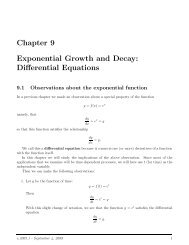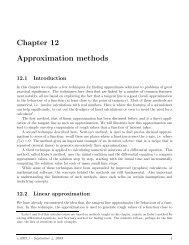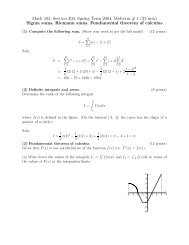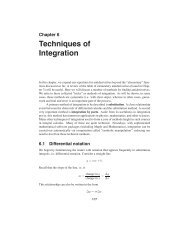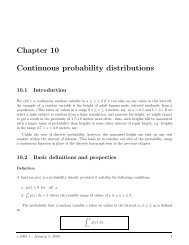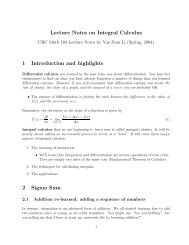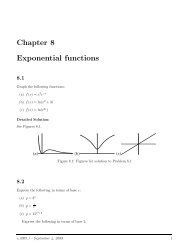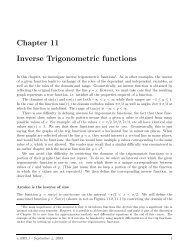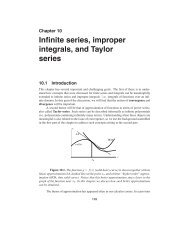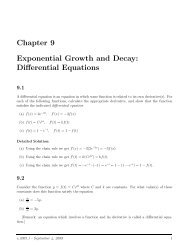Chapter 4 Applications of the definite integral to rates, velocities and ...
Chapter 4 Applications of the definite integral to rates, velocities and ...
Chapter 4 Applications of the definite integral to rates, velocities and ...
Create successful ePaper yourself
Turn your PDF publications into a flip-book with our unique Google optimized e-Paper software.
Math 103 Notes <strong>Chapter</strong> 4Integrating <strong>the</strong> above, we getR(t) − R(0) =(1.5t − cos(πs/5) ) ∣ ∣∣∣t.π/50Thus, using <strong>the</strong> initial value, R(0) = r 0 (which is a constant), <strong>and</strong> evaluating <strong>the</strong> <strong>integral</strong>, leads <strong>to</strong>R(t) = r 0 + 1.5t − 5 cos(πt/5)π(The constant at <strong>the</strong> end <strong>of</strong> <strong>the</strong> expression stems from <strong>the</strong> fact that cos(0) = 1.) A graph <strong>of</strong> <strong>the</strong>radius <strong>of</strong> <strong>the</strong> tree over time (using r 0 = 1) is shown in Figure 4.5. This function is equivalent <strong>to</strong><strong>the</strong> area associated with <strong>the</strong> function shown in Figure 4.4. Notice that Figure 4.5 confirms that <strong>the</strong>radius keeps growing over <strong>the</strong> entire period, but that its growth rate (slope <strong>of</strong> <strong>the</strong> curve) alternatesbetween higher <strong>and</strong> lower values.+ 5 π .25201510502 4 6 8 10 12 14tFigure 4.5: Rate <strong>of</strong> change <strong>of</strong> radius, f(t) for a growing tree.After ten years we haveBut cos(2π) = 1, soR(10) = r 0 + 15 − 5 π cos(2π) + 5 π .R(10) = r 0 + 15.(b) The mass <strong>of</strong> <strong>the</strong> tree is density times volume, <strong>and</strong> since <strong>the</strong> density is taken <strong>to</strong> be 1 gm/cm 3 ,we need only obtain <strong>the</strong> initial <strong>and</strong> final volume. Taking <strong>the</strong> trunk <strong>to</strong> be cylindrical means that <strong>the</strong>volume at a given time isV (t) = πR(t) 2 h.v.2005.1 - January 5, 2009 10



